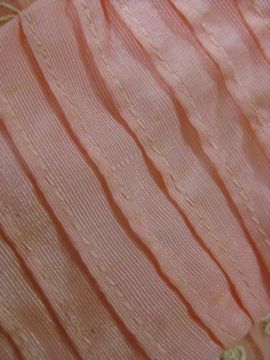The museum record for Emily’s pink dress states that it is ‘silk grosgrain’, which is true in a sense, but also highlights the problem with fabric terminologies (they aren’t precise! They change all the time! We don’t always know what they meant in the past!).
My challenge was to try to identify what Emily’s seamstress would have called the fabric, and to find the same fabric to make my recreation out of.
Both of those objectives turned out to be hideously difficult, and while I’ve arrived at some solutions, I’m not entirely happy with either result.
First, what is the fabric like?
It’s silk. It’s a pink with just a hint of yellow/orange that manages to be both very vivid, and quite subtle, at the same time. It has a very fine, very even rib running horizontally across the fabric (in other words, a weftwise rib). It handles like a very soft taffeta – flowing rather than rustling, but holding in the position it gets folded or sculpted to. The weight is also similar to a soft taffeta.
So what would Emily and her seamstress have called it? There are a few possibilities:
Silk grosgrain – this was used as a term for a fabric in the late 19th century and early 20th century. The fabric was particularly popular for trimming mourning clothes, the most popular treatment being to cut it into strips and sew these in stripes round the hem and sleeves of garments. The fabric was used as a trim in this manner so frequently that textile manufactures began making it as pre-cut ribbons, and the fabric itself became less and less common. Today grosgrain ribbons are quite common, but silk grosgrain is used almost exclusively for the lapels of mens formalwear, and may be a bit heavier than its 19th century counterpart.
Poult, or poult de soie – basically, a silk taffeta with heavy ribs. Today it is sometimes called faille taffeta. There seems to be some evidence that historically it could also have fine ribs, which would make it a good candidate for the fabric of Emily’s dress.
Peu de soie – used interchangeably with Duchesse satin today (I’ve even read snobbish accounts that say “those who cannot pronounce the proper French name call it Duchesse satin”), but historically applied to a softer, lighter fabric. There are some accounts that describe it as having a rib. Could this be Emily’s fabric?
Radzimir – A silk fabric with a fine rib, softer than taffeta, but still sculptable. I’ve found advertisements for this fabric in New Zealand at the time Emily’s dress was made. At different times radzimir has been used to describe fabric with lengthwise, crosswise, or broken twill ribs, and I can’t determine which it was used for in 1903. It was particularly common in black as a mourning fabric, but was seen for evening and formal wear, and became quite popular in the years after Queen Victoria’s death. Based on my research I think this is the most likely name that was applied to the original fabric of Emily’s dress.
Bengaline silk – Bengaline is sometimes considered to be a silk blend, but can be of pure silk. It has a crosswise ribbed effect, and was a common fabric at the turn of the century. Of course, the ribs run the wrong way.
And to add to the confusion, I’ve found descriptions of dresses made from corded silk – which could certainly describe the fabric of Emily’s dress. It’s not precise, but it works.
So, with a lot of ideas of what the fabric might have been called, I had to find a modern fabric that looks and acts the same. Easier said than done!



Yikes! What a task. But just think about the sense of achievement you’ll have when you’ve managed it. As someone who doesn’t have the patience for this level of recreational accuracy (current motto: it’s my Cranach gown and I will use synthetic lace if I want to) I am very impressed!
Beautiful!!! I love the idea. I want to do it!! (esp. dressing up to sew…what could be more fun?)